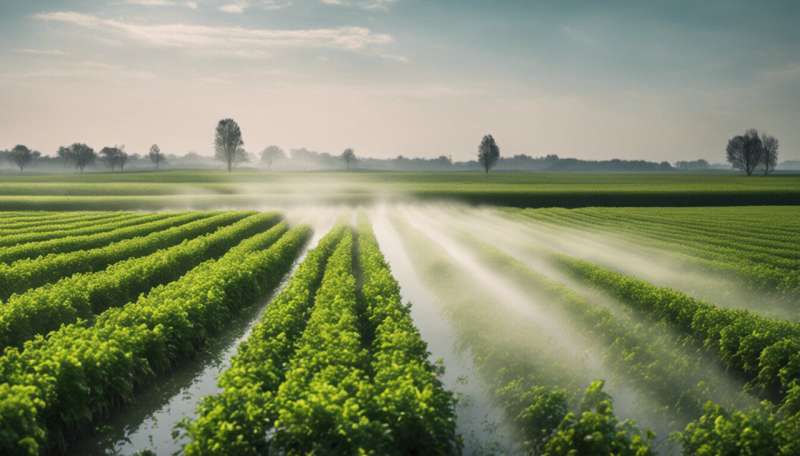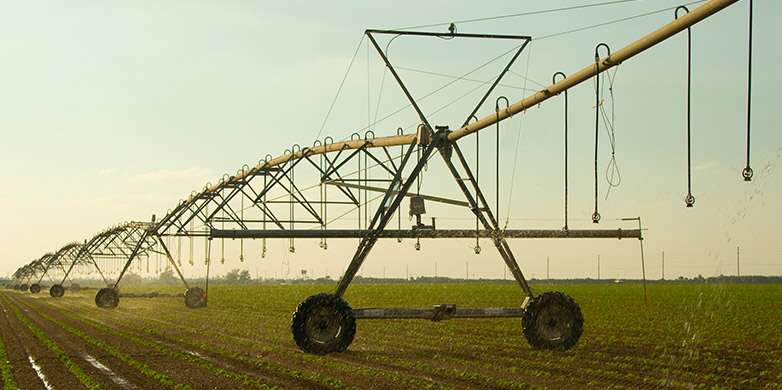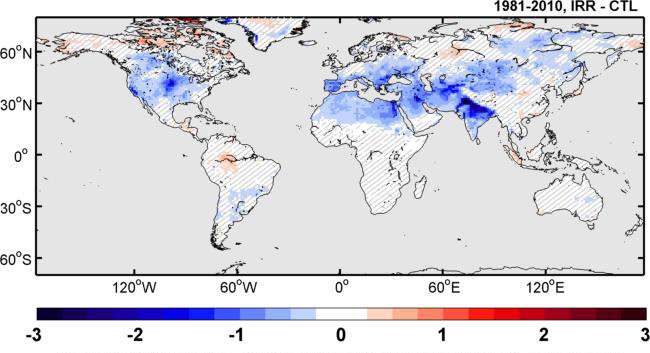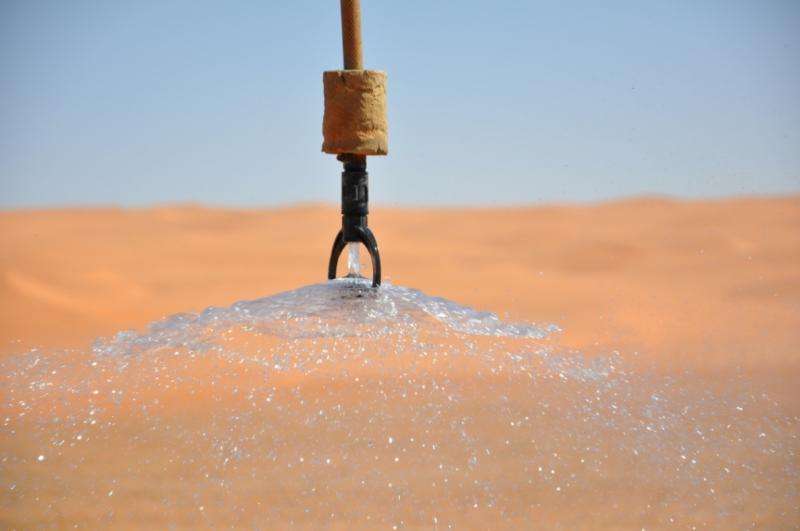The cooling effect of agricultural irrigation

Previously, scientists have suggested that agricultural irrigation affects mean climate in several regions of the world. New evidence now shows that this cooling influence is even more pronounced when it comes to climate extremes.
Irrigation is an essential practice for sustaining global food production and many regional economies. Although representing only about 2% of the global land surface, irrigated lands account for over 40% of global food production. To meet growing demand for food, irrigation amounts have been rising rapidly throughout the last century, with estimated total volumes increasing from around 500 km3 per year at the start of the twentieth century to 2,200–3,000 km3 per year around 2000.
Irrigation impacts on climate
Besides enhancing agricultural yields, irrigation also affects climate. The practice generally leads to cooling, but the effect is local and usually very small. This cooling occurs because solar energy arriving on an irrigated field evaporates the water rather than heating up the air above that field. Besides affecting temperature, irrigation may also change rainfall patterns. In India, for instance, irrigation is believed to lead to a reduction in rainfall. Yet how this practice influences climate extremes was so far unknown.

In a new study that combined the efforts of researchers from ETH Zurich and the Vrije Universiteit Brussel, Belgium, we were able to quantify this impact. In collaboration with the National Center for Atmospheric Research (NCAR) in Boulder, Colorado, we performed a number of climate simulations with an advanced computer model. We find that irrigation has a large impact on temperature extremes, with a particularly strong cooling effect during the hottest day of the year (−0.78 Kelvin averaged over irrigated land, see figure).
Cutting the extreme
There are two reasons why irrigation exerts a stronger influence on extremes than on mean climate. To start, farmers irrigate mostly when it is hot and dry, so obviously the effects during these periods will be larger. The second reason is more subtle: the regions in the world where humans irrigate are typically those where temperature fluctuations are very sensitive to the amount of water in the soil. These regions are neither dry nor wet, but somewhere in between (so called "transitional" regions). Systematically adding water to the soil through irrigation renders these regions less prone to the vagaries of climate.

Masking regional warming trends?
Our results indicate that the impact of irrigation on climate extremes is much more pronounced than its influence on the mean climate. This is highly relevant for understanding the past and possible future climatic effects of irrigation, particularly since most research to date has focused only on the influence on the mean climate. The strong response also suggests that irrigation may have masked warming trends for temperature extremes in some regions of the world. The next step for research thus consists of verifying whether irrigation-induced cooling has been offsetting CO2-induced warming.

Watering the world vs. water scarcity
Should we then start irrigating the whole world to reduce the negative consequences of global warming? Although this idea may sound attractive from a climate perspective, we most likely do not have enough water available for that. In India, irrigation is mostly needed during the hot and dry springtime months. During this time of the year, rivers are fed by meltwater from the Himalayas and there is some water available for irrigation. But in the Mediterranean, irrigation is most needed during the hot summer months, and this is of course also the time of the year when the rivers are almost running dry. Already today, we need five times more water for irrigation in the Mediterranean than is available from rivers (according to our simulations).
As the Mediterranean continues to dry out, we will have even less water available in the future. In such a scenario – where we cannot even sustain present-day irrigation rates – we may even see accelerated warming.
More information: Matthieu Guimberteau, Katia Laval, Alain Perrier, and Jan Polcher, Global effect of irrigation and its impact on the onset of the Indian summer monsoon, Climate Dynamics, 39, 1329-1348, 2012
Michael .J. Puma and Benjamin I. Cook, Effects of irrigation on global climate during the 20th century, Journal of Geophysical Research – Atmospheres, 115, 2010
Wim Thiery et al. Present-day irrigation mitigates heat extremes, Journal of Geophysical Research: Atmospheres (2017). DOI: 10.1002/2016JD025740
Sonia I. Seneviratne, Thierry Corti, Edouard L. Davin, Martin Hirschi, Eric B. Jaeger, Irene Lehner, Boris Orlowsky, Adriaan J. Teuling, Investigating soil moisture-climate interactions in a changing climate: A review, Earth Science Reviews, 99, 125-161, 2010
Journal information: Climate Dynamics , Journal of Geophysical Research - Atmospheres
Provided by ETH Zurich


















